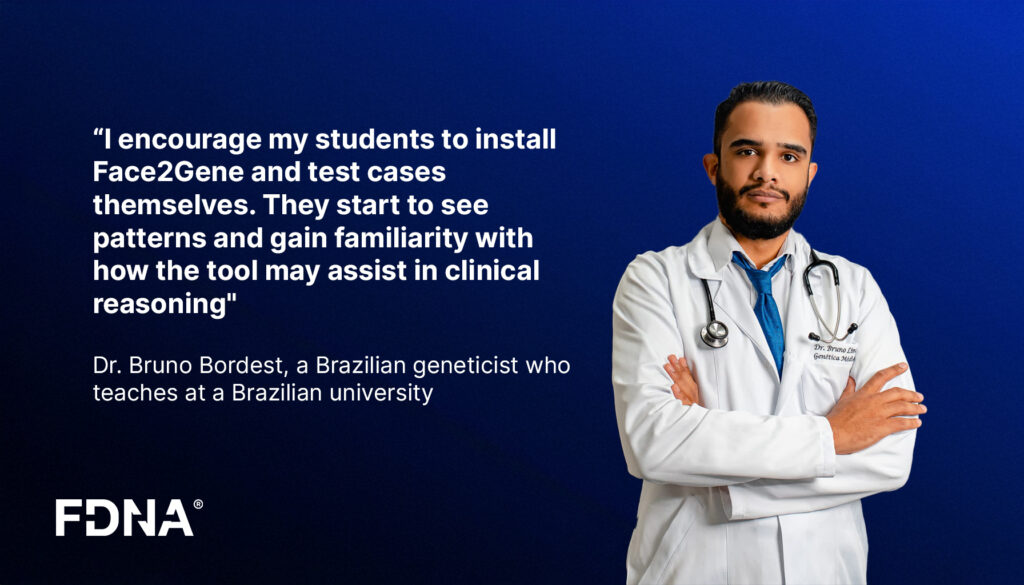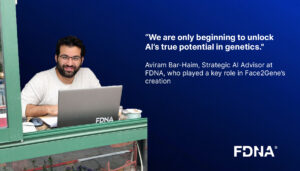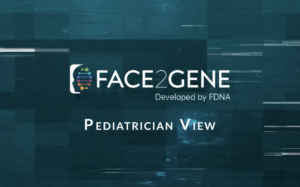In the world of rare genetic diseases, early diagnosis is often the key to better patient outcomes. However, the diagnostic journey can be long and complex, sometimes taking years before a definitive answer is found. Dr. Bruno Bordest, a Brazilian geneticist who teaches at the Universidade Federal de Mato Grosso, has been working to bridge this gap by introducing Face2Gene to pediatricians and general practitioners.
Dr. Bordest’s passion for genetics began early in his medical career. “Since medical school, I have always been interested in rare and atypical diseases,” he recalls. Despite a lack of formal training in medical genetics during his early years, he sought out every opportunity to learn. His journey eventually led him to discover Face2Gene, a tool that has since become an integral part of his practice.
He first encountered Face2Gene during his residency. “I had a colleague who was very enthusiastic about it, and he influenced me to start using it. At first, I was skeptical,” he admits. “But as I tested it on different cases, I realized the tool was providing information about potential conditions that, after clinical evaluation, aligned with confirmed diagnosis. That built my confidence in the technology.”
The Diagnostic Bottleneck and the Role of Pediatricians
The diagnostic odyssey for patients with rare genetic disorders often takes an average of four years, though in many cases, it takes much longer. Dr. Bordest sees several reasons for this delay. “Primary care physicians are overwhelmed with common conditions – growth and development issues, infections, and routine pediatric concerns. Rare diseases often go unnoticed in this busy environment.”
Another challenge is the lack of specialists. “In my region, we have almost 8 million people for 2 geneticists. That creates a huge bottleneck in getting patients to a proper diagnosis.” Face2Gene, however, may assist in supporting the diagnostic process. “The tool can aid primary care doctors in identifying cases that might benefit from genetic evaluation and allows specialists to prioritize testing more effectively.”
Dr. Bordest emphasizes that Face2Gene is not just for geneticists. “Pediatricians can use it as a support tool to differentiate between normal variations in appearance and potential genetic syndromes.” He shared a powerful example: “One of my former residents saw a child with short stature and used Face2Gene. The app flagged features consistent with Noonan Syndrome, supporting her clinical decision to order an echocardiogram. The heart scan revealed an undiagnosed congenital heart defect, allowing for early intervention before the child even reached my office.”
Teaching the Next Generation
As a preceptor at a major hospital, Dr. Bordest ensures that all his students, from general medical trainees to pediatric residents, are exposed to Face2Gene. “Every week, we use the app in the clinic, and I encourage my students to install it and test cases themselves. They start to see patterns and gain familiarity with how the tool may assist in clinical reasoning.”
The response from his students has been overwhelmingly positive. “Many of them now use Face2Gene regularly. Some have even contributed to important case insights during their shifts. I tell them, ‘If you ever feel uncertain about a case, use the app. If you don’t see anything unusual, use it anyway.”
Dr. Bordest believes Face2Gene should be more widely promoted among pediatricians. “At genetic conferences, everyone already knows about it. But at pediatric conferences, very few doctors are aware of it. That’s where the real change needs to happen.” He sees a major opportunity to integrate Face2Gene into pediatric education and practice, helping reduce the time it takes for patients to receive an accurate diagnosis.
His experience has changed his own approach to using the app. “There was a time when I only used Face2Gene for very obvious cases, but now I use it for everything. Even when I don’t suspect a syndrome, I take a photo and check. The technology may help identify subtle features that are easy to overlook, even for experienced geneticists.”
Through his teaching and advocacy, Dr. Bordest is helping to ensure that more doctors have access to this powerful tool, ultimately improving the lives of patients with rare genetic conditions.



